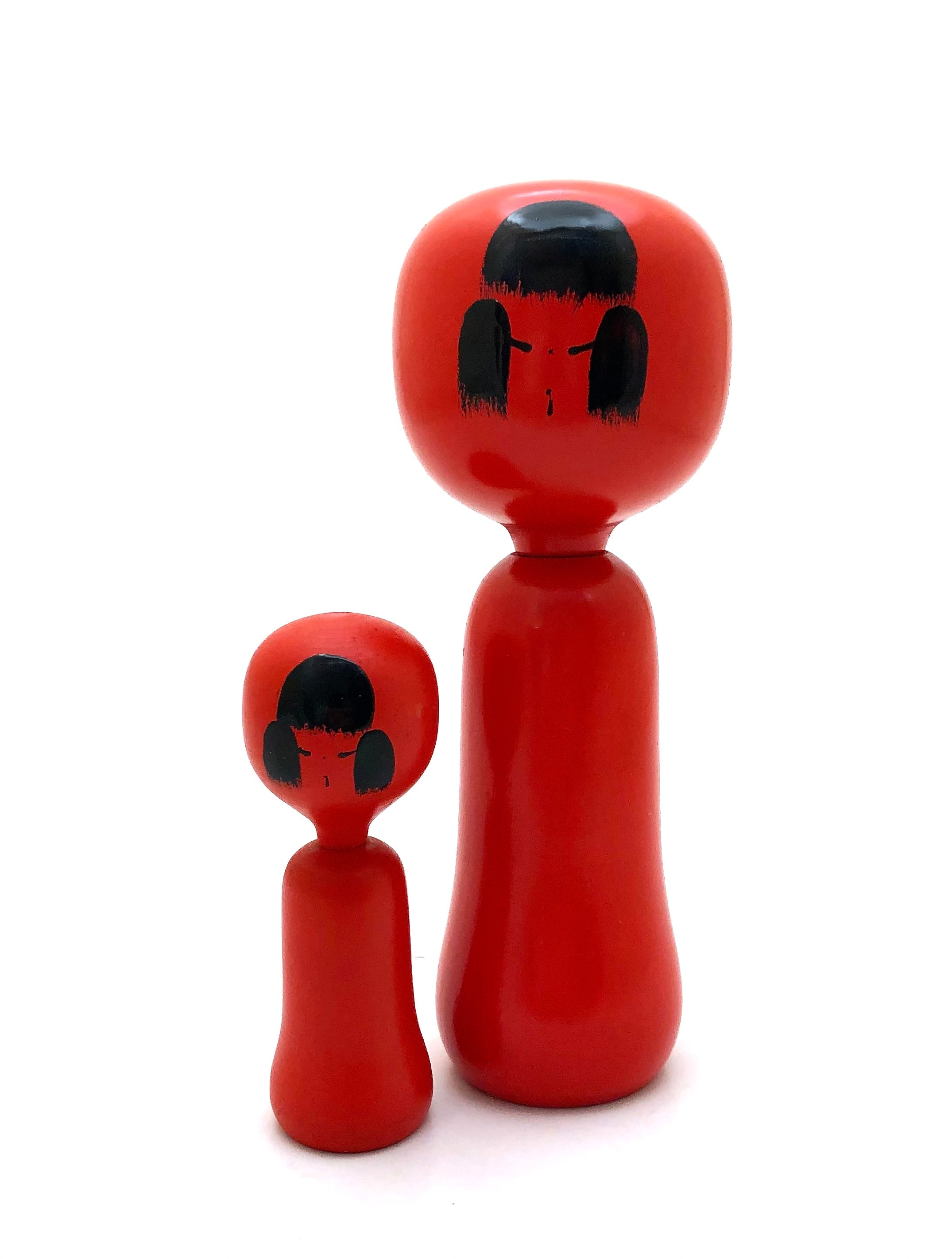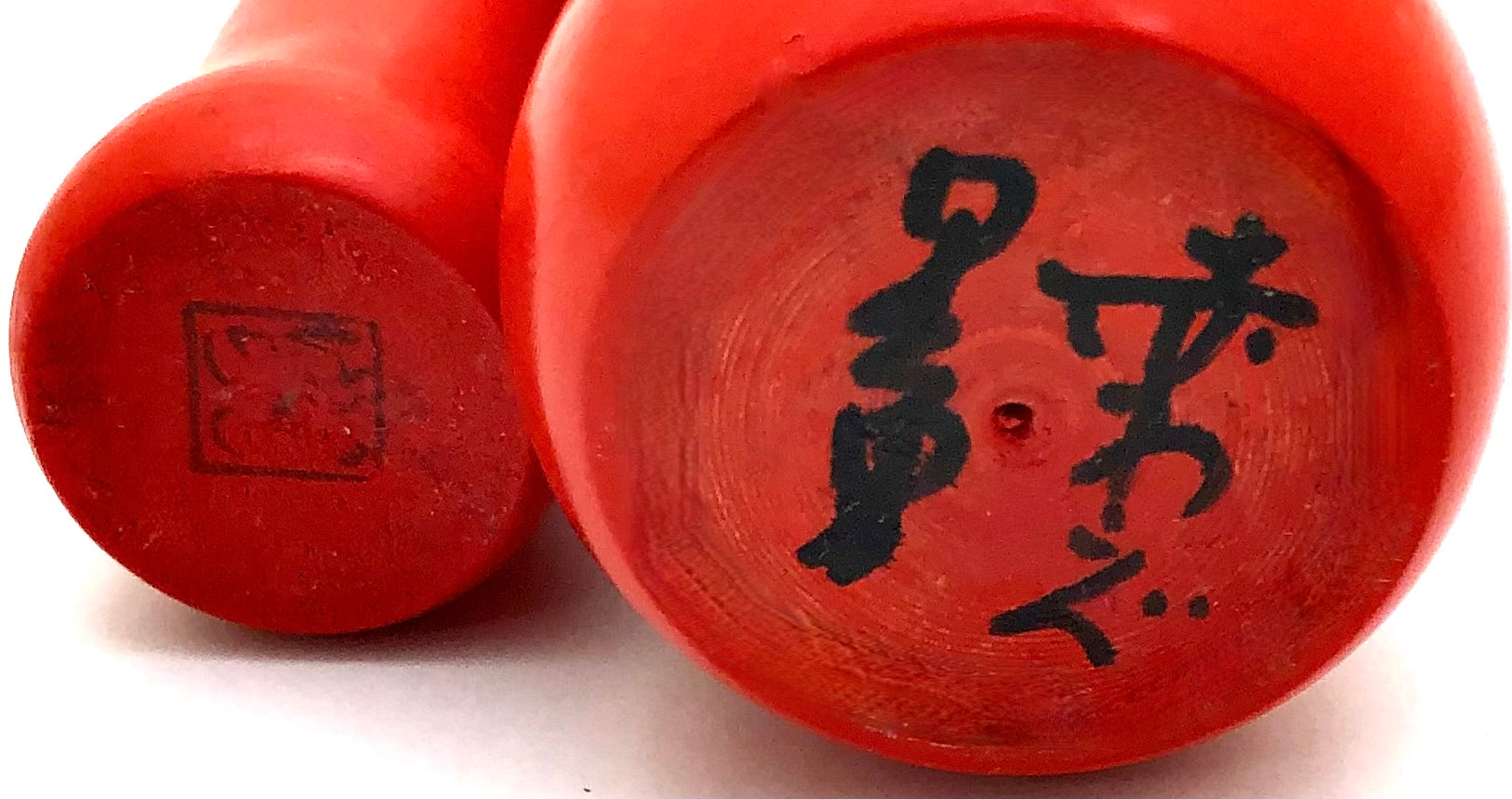

Vintage Sosaku Kokeshi Siblings by Ishihara Hideo "Aka Warabe | Red Kid; (Kuro Kami | Black Hair”
Dimensions: 3-3/4”h; 7-0”h
This wonderful pair of two siblings which are associated with two names as shown in this title, and are found in a 1970s book featuring Ishihara-san's work. They are Narugo-inspired siblings. The vermilion red lacquer painting of each body breaks with tradition, while the distinctly Narugo face with the black accentuated hair is firmly in the style of the family of traditional dolls. Ishihara was awarded a special award with a similar Kokeshi at the 15th All Nippon Kokeshi contest that was held in 1968. The larger doll has Ishihara’s script signature and the smaller doll has his impressed stamp.
It is our understanding from readings as to why Ishihara was inspired to lacquer the body of these dolls red. During this period of time, superstition play a large part in raising a child, and “Red is believed to protect children from evil”. Since ancient times, people in Japan have regarded red as a color that denotes the power of the sun, and also that of blood – the power to protect humans from evil and harm. Therefore, some people put red clothing on their children, including red underwear, to gain spiritual empowerment and encouragement. Red is the color of festivals and has a symbolic meaning of peace and prosperity for the family.
A final note about Ishihara’s use of black bangs and side fringes with minimal facial features. Japanese have all colors of hair just like many other cultures. But long, black hair was a sign of beauty for women in the Heian period (794-1192) when Japan developed its own cultural preferences. So children with black hair were considered exceptionally beautiful, and we have found such preferences portrayed in many forms of art, including Kokeshi.
Condition. Excellent condition commensurate with age, having an exceptional quality of lacquer work on beautifully-turned figures. There are no scratches, flake-off, cracks, or imperfections. Meets the high standards of the collector of the works of Sosaku Kokeshi by the masters.

Artisan
Woodworker: Ishihara, Hideo
1925 - 1999
Biographical History:
Hideo graduated from Tohoku University with a degree in science. His grandfather was Iwataro Onuma, the Kokeshi artist credited with originating Naruto Kokeshi, perhaps the most famous style or strain of traditional Kokeshi types. Upon recovering from his illness, he moved to Sendai and began making Sosaku Kokeshi, and in ten years (1959-1969). During his medical treatment, he studied painting under Genichiro Inokuma. He lost interest in the traditional Kokeshi forms for he felt they were stagnating by family standards, and became an avid proponent of Sosaku Kokeshi allowing him the artistic freedom to experiment with various designs and forms. In 1964, he organized the Poetic Craft Exhibition and received more than sixty awards, including the highest honor, the Prime Minister’s Award. He was introduced to the twenty-three countries in Europe and America by NHK. He has sponsored 30 exhibitions in Japan including those at Matsuzakaya Nagoya and Ginza, and four exhibitions in overseas countries. He was one of the founders of the NKAHA, (Nippon Kokeshi Artistic Handicraft Association).
Collector's note – descriptive qualities, standard characteristics & ornamentation styles:
Ishihara-san’s dolls are based on many motifs found in nature and textile design. He loves portraying both young and old characters with differing hairstyles, (traditional and 1950s era). He illustrates numerous kimono styles in both painted form and carving and utilizes simple graphic treatment to emphasize the strong character of his dolls, which bring out the true nature of the wood materials through manipulation of the turned and carved wood. His dolls are always finished in a simple wax coating. It is also not unusual to see Hideo utilize sumi-e’ drawing of faces that have both the ‘one-stroke eye treatments, (Hitofude-me), as well as a variation of expressive renditions.
Explore & Learn More about Woodworker: Ishihara, Hideo